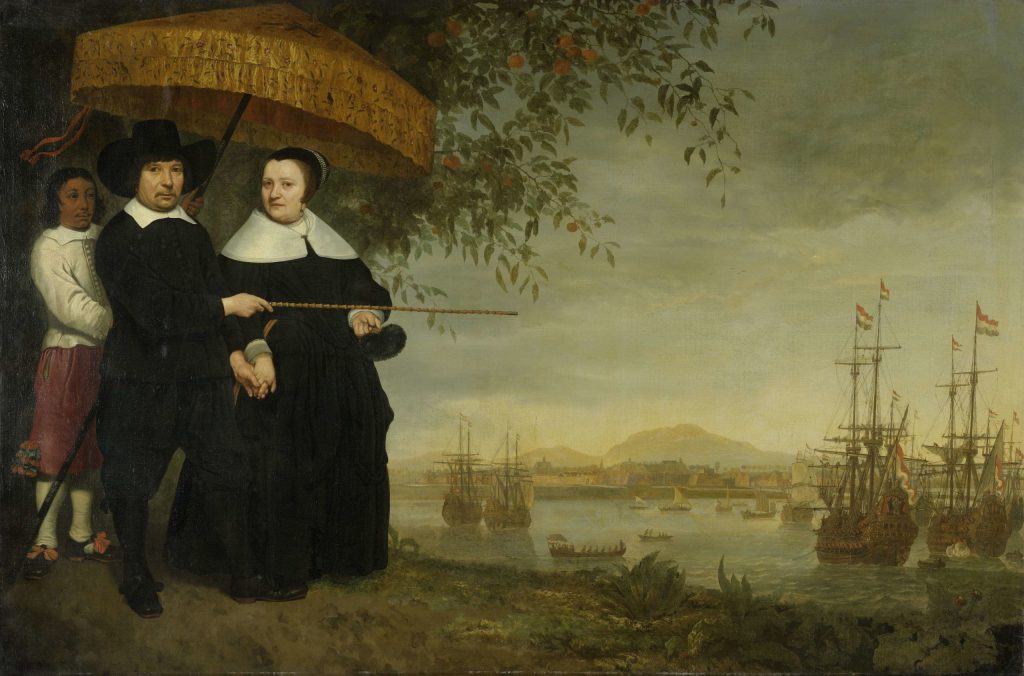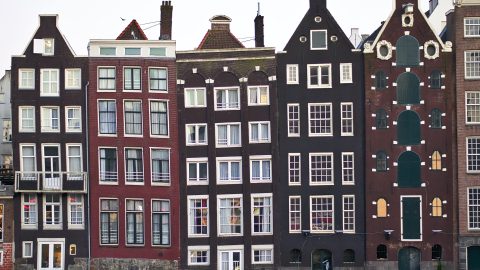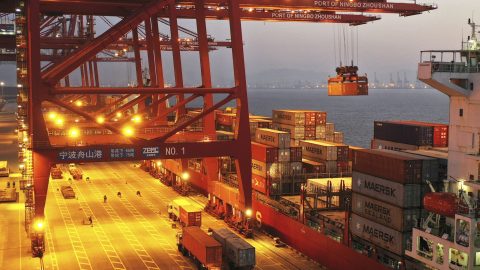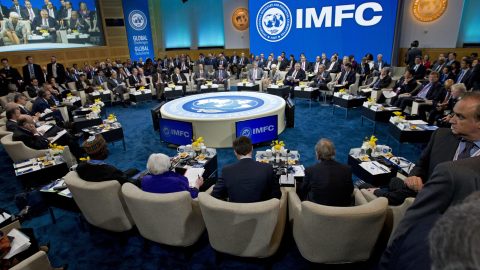On a late summer night in Amsterdam, Saturday the 31st of August, the year 1602, Notary Jan Fransz Bruyningh left his house at the Heintje Hoeksteeg. Heading through the Warmoesstraat, he went to the house of merchant Dirck van Os at the Nes. All these street names still exist more than 400 years later.
Vereenigde Oostindische Compagnie – the beginning of “capitalism”
Dirck van Os was one of the directors of de Vereenigde Oostindische Compagnie (VOC), “Dutch East-India Company” (although, precisely, “Vereenigde” means “United”). At his private quarters, people could sign up to participate in the capital of the VOC, founded earlier in the same year. The book was closed at midnight, and under the watchful eye of Notary Bruyning accountant Lampe was making up the balance.
Shortly before closure, Neeltgen Cornelis, the housemaid of Dirck van Os, came in to also sign up for 100 guilders. Earning half a guilder a day, this was quite a sum for her. Although after much hesitation and seeing so many investors coming in, she would become probably one of the first recorded cases of FOMO (“Fear Of Missing Out”) at the birth of the first tranche of equity.
Exchanging capital for the first time – the birth of the stock exchange
The participation in capital was not new, the VOC being the united companies that had sailed to the East since 1595. These were mostly invested in by a coupled of wealthy private investors. Because of the huge venture of these individual companies combined under one umbrella, it was decided to make the subscription public. Everybody living in the Dutch Republic at the time could participate. It wasn’t seen just as an investment to earn money with, it was also a patriotic act for the inhabitants of the young republic.
At 21 years, the investment had an exceptionally long duration. The directors of VOC realized that this fact would scare off potential investors. Therefore, they decided to add the following provision:
”Transporten of overdrachten kunnen gedaan worden bij de boekhouder van deze kamer”
Transports or transfers [of equity] can be made by the bookkeeper of this chamber.
This was the first time in history that the option of exchanging equity was officially documented.
A war as trigger
The reason why it came to this, sadly, was a war, i.e. the Dutch uprising against Spain in the 16th century.
In the Carol Reed movie, The Third Man, Orson Welles’ character Harry Lime famously, and cynically, says: “In Italy for thirty years under the Borgias, they had warfare, terror, murder, and bloodshed, but they produced Michelangelo, Leonardo da Vinci, and the Renaissance. In Switzerland, they had brotherly love, they had five hundred years of democracy and peace, and what did that produce? The cuckoo clock.”
The uprising originally started because of the Reformation. What is now known as Belgium and the Netherlands, were the Seventeen Provinces, the imperial states of the Habsburg Netherlands in the 16th century. After the abdication of the Habsburg Emperor Charles V in 1555, the Seventeen Provinces went to his son, Philip II of Habsburg, the King of Spain.
Conflicts about religion, where Philip II wanted a much stricter rule against the Reformation than his Dutch subjects were willing to accept, led to the Eighty Years’ War, starting in 1568. The Dutch local authorities were much more inclined to tolerate new thoughts in general, and also on religion. The region being central to many trading routes from all over Europe, tolerance was embedded in their society.

Moving North – the Seven United Provinces
Seven northern provinces managed to gain independence as a republic called the Seven United Provinces. In the South, Philip II managed to restore his rule, causing many people from the southern provinces to flee to the new republic, where there was a much wider acceptance for diversity. This also meant a lot of wealth from Antwerp, Bruges, Ghent, and Brussels was moving North. Soon enough people from all over Europe who suffered from any kind of repression would find shelter in the Republic.
At war with the most powerful nation on earth, the Seven United Provinces were now full of rich merchants and other talented people. As a collateral damage of the struggle for independency, a lot of former trade routes were severely disrupted or even completely blocked. These merchants with means, knowledge, and connections soon started to look for new opportunities. After Portugal fell to Spain in 1580, suddenly the Republic was also at war with the sole beneficiary of the trade route to East-India, which offered a unique, albeit risky, opportunity.
In 1595, the first Dutch ships sailed to East-India. They were property of the private company “Compagnie van Verre” (“Company from far away”), and although they were not very successful at first, they still proved it was possible to trade directly with East-India. More and more such undertakings followed, in the process not only competing with Portugal, but also with each other.
Trade monopoly
The government of the republic was not overly happy with this situation. Given that it was still at war, it would be much more beneficial to bundle the efforts and only compete against Portugal. Hence, the East-Indian Trading Company was born, and it was given the monopoly to trade between the East Indies and the Republic. In exchange, it had to represent the interests of the republic, by any means necessary.
VOC was nearly three times the market cap of Apple
After 1602, it still took a while before stock-trading really started to look like a modern stock exchange. Again, war and battles accelerated this. The VOC became very successful after a while, helped by strongly sub-par ethics (not only compared to modern standards), and the value of the stock began to rise sharply. At its peak the VOC was worth 78 Million Dutch guilder, which adjusted, among other things for inflation, would be tantamount to an estimated USD 7.9 trillion nowadays. Compare this to Apple’s market cap of approximately USD 2.9 trillion.
Prices were very volatile, especially since the young republic was almost permanently at war in the 17th century, not only with Spain. Investors recognised it was not only rewarding to be invested in the company, but also to trade the equity, selling at high levels and buying back at lower levels later. Thus, speculating on negative news (e.g. that a ship had sunk), or even trying to spread rumours which were not true in the first place, were strategies of manipulating the price as seen fit. First regulations had to be imposed. Pigeons were used to get the latest news before others got it: the modern-day equivalent of high-speed data connections.
All this combined eventually meant a huge leap forward in the efficient allocation of capital and available resources.
Stock exchange for everyone
Neeltgen Cornelis never really came to benefit from this. She sold her shares less than a year later; she probably had to sell them because she could not afford the first payment. When subscribing she did not have to provide all the money at once. She could have paid in four instalments.
But although she never got any reward for her brave and patriotic act of participating in this enormous financial innovation, she could still be regarded as a symbol of this new form of trade, which created chances for more people than ever before, regardless of their background.
Recommended reading: The World’s first stock exchange (Columbia Business School Publishing) by Petram Lodewijk
Legal disclaimer
This document is an advertisement. Unless indicated otherwise, source: Erste Asset Management GmbH. The language of communication of the sales offices is German and the languages of communication of the Management Company also include English.
The prospectus for UCITS funds (including any amendments) is prepared and published in accordance with the provisions of the InvFG 2011 as amended. Information for Investors pursuant to § 21 AIFMG is prepared for the alternative investment funds (AIF) administered by Erste Asset Management GmbH pursuant to the provisions of the AIFMG in conjunction with the InvFG 2011.
The currently valid versions of the prospectus, the Information for Investors pursuant to § 21 AIFMG, and the key information document can be found on the website www.erste-am.com under “Mandatory publications” and can be obtained free of charge by interested investors at the offices of the Management Company and at the offices of the depositary bank. The exact date of the most recent publication of the prospectus, the languages in which the key information document is available, and any other locations where the documents can be obtained are indicated on the website www.erste-am.com. A summary of the investor rights is available in German and English on the website www.erste-am.com/investor-rights and can also be obtained from the Management Company.
The Management Company can decide to suspend the provisions it has taken for the sale of unit certificates in other countries in accordance with the regulatory requirements.
Note: You are about to purchase a product that may be difficult to understand. We recommend that you read the indicated fund documents before making an investment decision. In addition to the locations listed above, you can obtain these documents free of charge at the offices of the referring Sparkassen bank and the offices of Erste Bank der oesterreichischen Sparkassen AG. You can also access these documents electronically at www.erste-am.com.
N.B.: The performance scenarios listed in the key information document are based on a calculation method that is specified in an EU regulation. The future market development cannot be accurately predicted. The depicted performance scenarios merely present potential earnings, but are based on the earnings in the recent past. The actual earnings may be lower than indicated. Our analyses and conclusions are general in nature and do not take into account the individual characteristics of our investors in terms of earnings, taxation, experience and knowledge, investment objective, financial position, capacity for loss, and risk tolerance.
Please note: Past performance is not a reliable indicator of the future performance of a fund. Investments in securities entail risks in addition to the opportunities presented here. The value of units and their earnings can rise and fall. Changes in exchange rates can also have a positive or negative effect on the value of an investment. For this reason, you may receive less than your originally invested amount when you redeem your units. Persons who are interested in purchasing units in investment funds are advised to read the current fund prospectus(es) and the Information for Investors pursuant to § 21 AIFMG, especially the risk notices they contain, before making an investment decision. If the fund currency is different than the investor’s home currency, changes in the relevant exchange rate can positively or negatively influence the value of the investment and the amount of the costs associated with the fund in the home currency.
We are not permitted to directly or indirectly offer, sell, transfer, or deliver this financial product to natural or legal persons whose place of residence or domicile is located in a country where this is legally prohibited. In this case, we may not provide any product information, either.
Please consult the corresponding information in the fund prospectus and the Information for Investors pursuant to § 21 AIFMG for restrictions on the sale of the fund to American or Russian citizens.
It is expressly noted that this communication does not provide any investment recommendations, but only expresses our current market assessment. Thus, this communication is not a substitute for investment advice, does not take into account the legal regulations aimed at promoting the independence of financial analyses, and is not subject to a prohibition on trading following the distribution of financial analyses.
This document does not represent a sales activity of the Management Company and therefore may not be construed as an offer for the purchase or sale of financial or investment instruments.
Erste Asset Management GmbH is affiliated with the referring Sparkassen banks and Erste Bank.
Please also read the “Information about us and our securities services” published by your bank.
Subject to misprints and errors.



